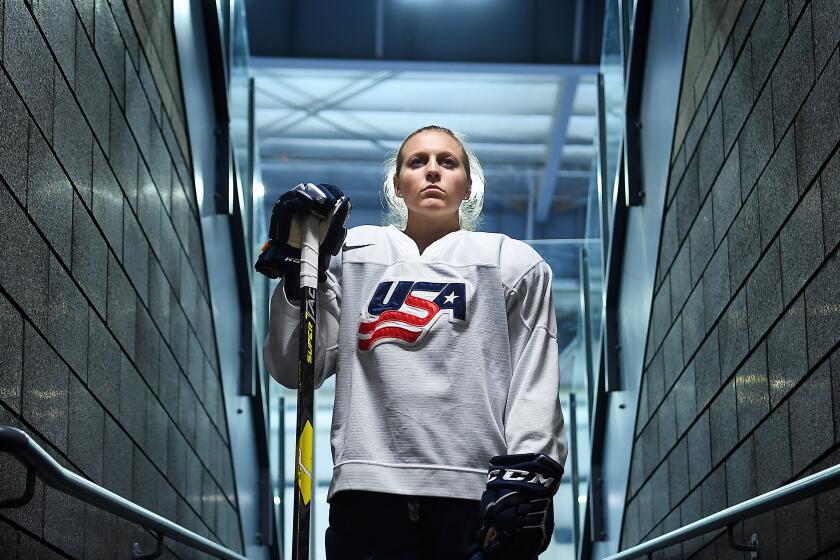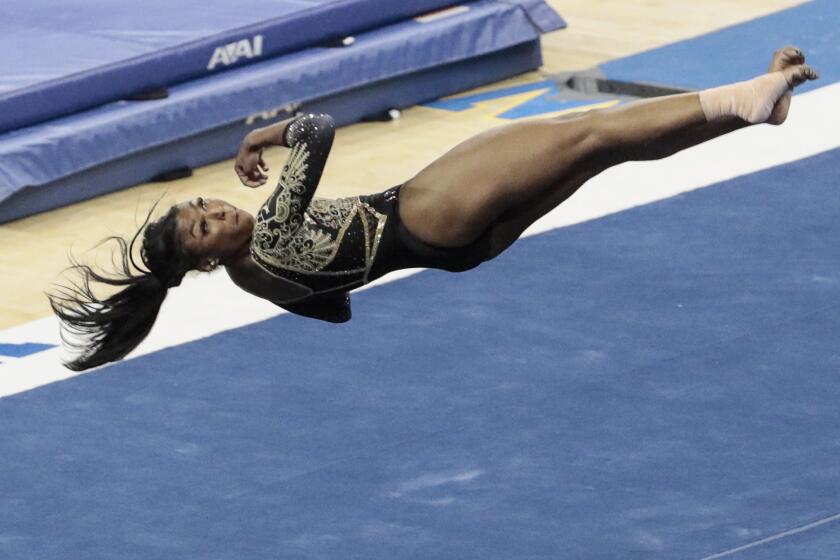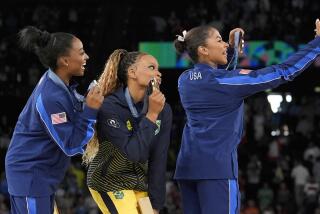Column: ‘Dream Gap’ tour inches women’s pro hockey association toward financial viability
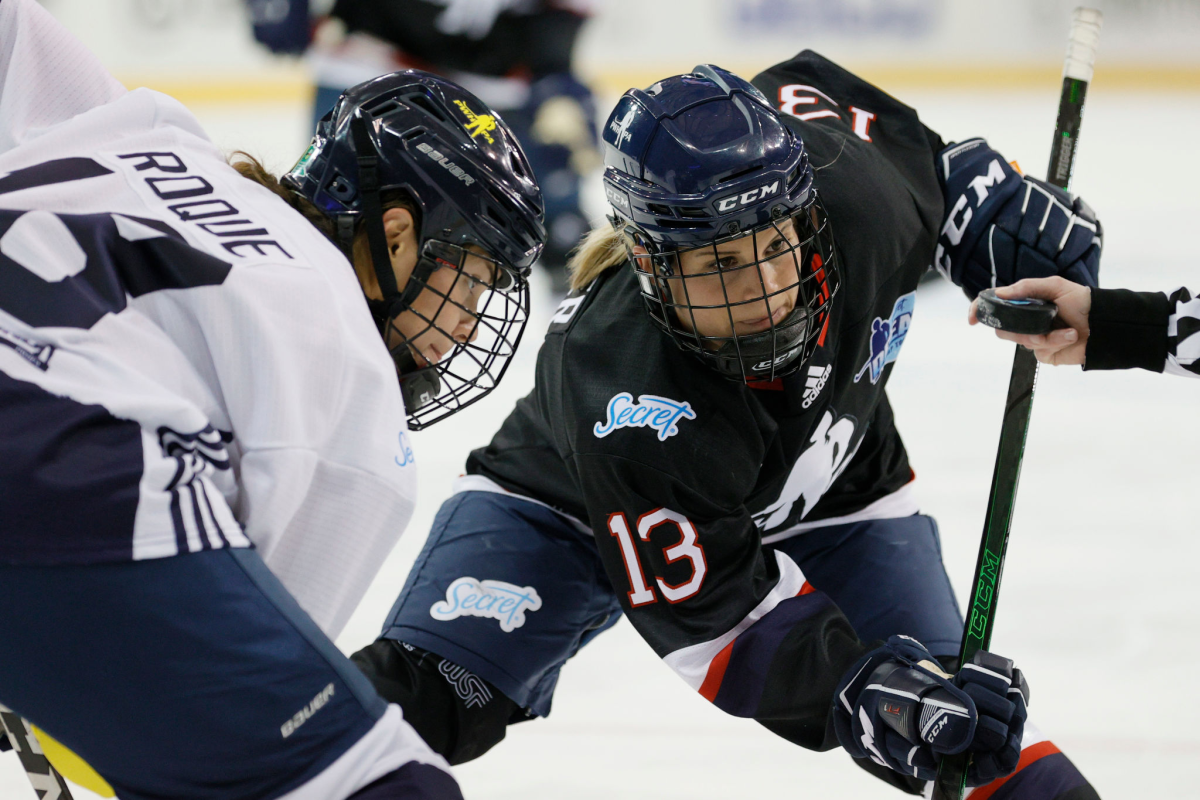
- Share via
Between the vision of a sustainable women’s league that pays a living wage and the current reality of having scarce resources, little visibility and part-time jobs is the chasm that explains the name of the Professional Women’s Hockey Players Assn.’s “Dream Gap” tour.
The gap between what is and what they hope will come to pass is narrowing slowly. It closes with each stop on the tour, which Saturday will reach the United Center in Chicago. The game will air at noon Pacific on NBCSN with a team of female broadcasters and U.S. Olympian Kendall Coyne Schofield wearing a microphone.
The gap closes a little each time they showcase their skills and share their remarkable stories, as they did last week at Madison Square Garden in a game broadcast on the NHL Network and Canada’s Sportsnet. “A watershed moment for women’s hockey,” said Mary-Kay Messier, vice president of global marketing for Bauer Hockey.
Blake Bolden, a scout for the Kings and their growth and inclusion specialist, felt the weight of the occasion as a TV analyst. “It was so many girls’ dreams coming true, and you felt the energy in the building even without fans,” she said. “It was a powerful day.”
The gap closes each time the women inspire a “see it, be it” moment that changes a child’s life. “It’s important to develop young girls through sports, develop leadership, to keep people in the game, to keep hockey healthy for years to come,” said Jayna Hefford, a Hockey Hall of Fame player and PWHPA operations consultant. “We always talk about hockey is for everyone, but to be healthy in the long term you’ve got to have that 50% of the population that sees themselves as part of the game, one way or the other, if it’s as a fan, competing, or in an executive or leadership position.”
Nearly 50 years after Congress passed Title IX, female athletes are still scrambling for a fair shot in the male-dominated world of sport. In hockey, top Americans and Canadians train with their national teams part-time; the rest of the season, they have only a small pro league that offers twice-a-week practices, weekend games and thin salaries.
The PWHPA was born in 2019 with the aim of creating and promoting a viable professional hockey league for women. There have been pro leagues and the National Women’s Hockey League still exists, though its players get little pay and its season ended abruptly when the coronavirus breached its bubble in Lake Placid, N.Y. Members of the PWHPA chose not to play in the NWHL. Instead, they’re strategizing to build a league that will be financially stable, inclusive and forward-looking.
It’s an ambitious goal. The pandemic, which limited the scope of the tour and potential revenues, also prevented Canadian players from participating. The vision is crystallizing more slowly than everyone would like.
“When you’re so close to it and you’re a player — and I’m wearing my player hat — I wanted it yesterday and we needed it yesterday,” U.S. national team member Hilary Knight said. “But when you take a step back you’re able to see it from a different viewpoint. What we’re doing today, we’re making amazing strides and we’re going to get where we need to be eventually. But we can’t make rash decisions.
“I think that’s been the hardest part, to collectively move forward understanding that you wanted these things yesterday but the reality is they weren’t created yesterday, and sometimes it takes a bold group of women to stand up and forego the easy today for a better tomorrow.”
The NHL has been supportive of women’s hockey and invited female players to participate in its last two All-Star Game weekends, but it stayed on the sidelines while the NWHL and now-defunct Canadian Women’s Hockey League were rivals. The NHL hasn’t endorsed a league in the way the NBA did in launching and funding the WNBA.
Alex Morgan, Sue Bird, Chloe Kim and Simone Manuel combine forces to launch Togethxr, a new media company highlighting women in sports and culture.
Instead of waiting for the NHL to provide funding — and possibly take ownership of its future — the PWHPA found its own sponsors. Secret deodorant, which donated $529,000 to close the pay gap the 2019 U.S. women’s soccer team experienced compared to its male counterparts, is the primary Dream Gap tour sponsor. The Women’s Sports Foundation and Adidas also are sponsors. JP Morgan Chase was a presenting sponsor in New York and AT&T will be a presenting sponsor in Chicago. In addition, the Mark Messier Foundation, overseen by the six-time Stanley Cup champion (and brother to Bauer’s Mary-Kay Messier), vowed to match donations to the PWHPA up to $100,000.
Also of significance, the PWHPA has been working with individual NHL clubs, forging valuable partnerships with the Toronto Maple Leafs, New York Rangers, Philadelphia Flyers and Chicago Blackhawks. “Instead of thinking, ‘What can the NHL do for us?’ How about, ‘How do we envision the future?’” Mary-Kay Messier said. “In some ways, why do we even want it to come from the NHL? Why not come from the women who have an idea of what the vision of girls’ and women’s hockey should look like?”
Hefford said the NHL will play “a strong role in the future of a women’s professional league,” but working with clubs has been mutually beneficial. “We feel the relationships we’ve been building with the clubs has been really successful because they’re the ones that can really activate on them. They’re excited to be a part of it, they share our vision of what professional women’s hockey should look like and I think they take it to their regional level and see it as an opportunity to grow the game within their region,” Hefford said.
The PWHPA also gains stature by association with long-established NHL teams. “It’s demonstrating that they see value in what we’re doing,” Knight said, “and not only is it providing the credibility within the hockey space and hockey community it’s also opening up new doors and having different synergies between our programs and shared services with these other clubs that helped create a platform for a sport, because that’s something we’ve truly been missing for so many years. The visibility component has been the hardest one to overcome.”
Coyne Schofield also sees a great need to elevate the women’s profile. “Look at the visibility of the women’s soccer team. I can walk into Dick’s Sporting Goods and get an Alex Morgan jersey if I wanted to,” Coyne Schofield said. “You look at their social media channels: they have over 4 million followers combined and we don’t even have social media channels with the women’s national hockey team.”
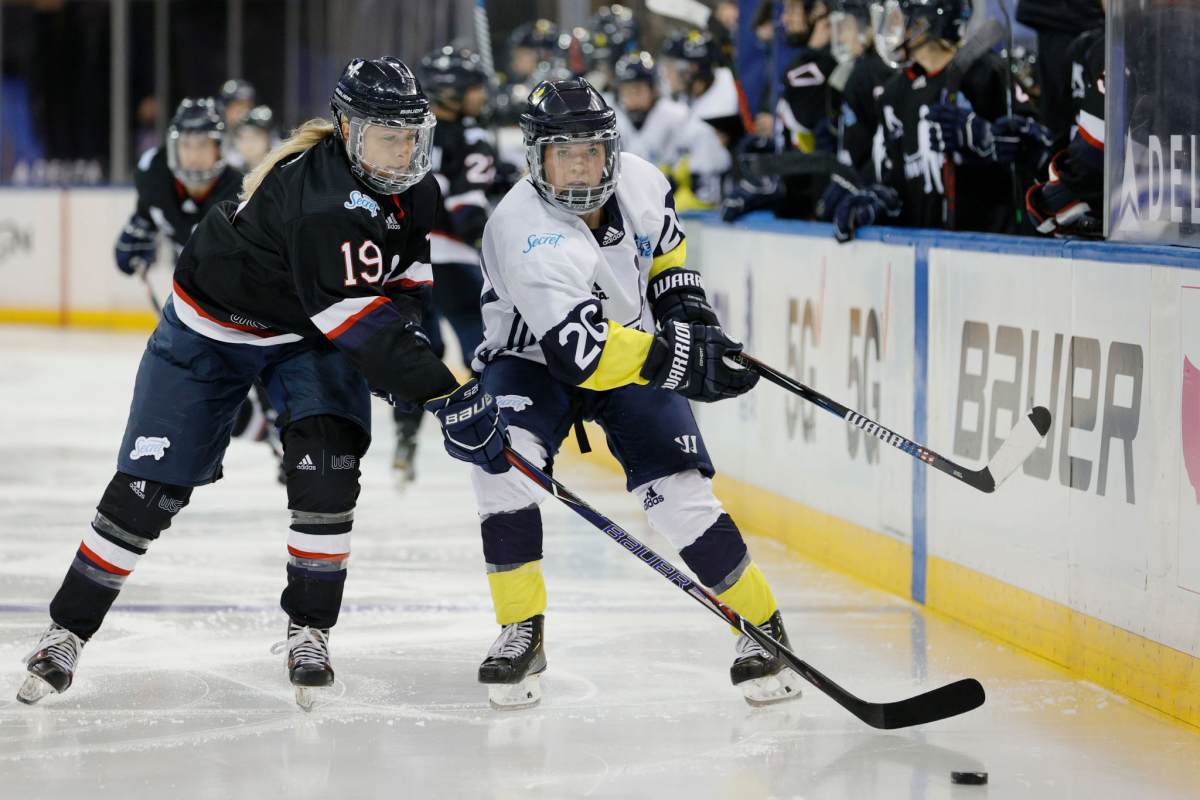
Interest in women’s hockey typically peaks during the Winter Olympics, but the grind doesn’t stop in the four years between the Games. As part of the resolution of a dispute between the U.S. women’s national team and USA Hockey, a series between the U.S. and Canada — the top women’s international hockey powers — was established to give the women chances to play and popularize the game. A matchup between the U.S. and Canada drew 13,320 fans to Honda Center on Feb. 8, 2020, a record for the U.S. national team on home soil, but such games are rare. The Dream Gap tour hopes to have one or two more stops but nothing is certain. The 2020 world championships were cancelled because of the pandemic and this year’s competition in Nova Scotia has been pushed back a month to May.
Coyne Schofield, whose blazing speed electrified a wide audience when she competed in the 2019 NHL All-Star skills competition, said she was delighted when friends told her they enjoyed last week’s game in New York but was sad on another level. “It’s always so bittersweet for me to hear from so many people after we play because we play like that every day but we don’t have the platform to play on every day,” she said. “When we do, everyone’s like, ‘Wow, women’s hockey is awesome.’ And my response is, ‘It’s awesome every day.’
“It goes back to the All-Star weekend. That was an incredible moment for the game. What was so challenging for me was not being able to direct people’s attention to a consistent landscape of women’s hockey where they can go find us on a regular basis. Or it’s like, ‘Wait four months and two weeks until the world championships.’ You’ve lost them right there. You need to have somewhere to go, have a home base, and those are things that I hope to see in the future as well.”
Coyne Schofield and her husband Michael, an NFL offensive tackle who spent three seasons with the Chargers, recently joined a new investor group behind the National Women’s Soccer League Chicago Red Stars. “When this opportunity presented itself to us it was a no-brainer,” she said, “because we know the need for people to invest and support and advance women’s sports if we want to continue to close that gap.” They continued a mini-trend of celebrities and athletes investing in the NWSL; Serena Williams and her husband Alexis Ohanian, actresses Eva Longoria, Jennifer Garner and Natalie Portman and more than a dozen former members of the U.S. women’s soccer team are among the owners of the Angel City soccer team, which is scheduled to debut next year in Los Angeles.
For columnist Dylan Hernández, it’s easy to see why UCLA gymnastics, and its push for social equality, is so popular with his 10-year-old daughter.
Would a prospective women’s hockey league benefit from famous investors? “I don’t see why it wouldn’t work,” Hefford said. “When you’re trying to get things up off the ground, A, you need the financial investment and B, to have the platform of people who have influence publicly is certainly key.”
Coyne Schofield estimated that women’s soccer is about 20 years ahead of where women’s hockey is. “We are seeing the success of the NWSL take off because of the amount of capital and the amount of people who are investing in women’s sports, and that’s not just a dollar amount,” she said. “That’s also awareness, that’s broadcasting partners, that’s resources.”
The NWSL stands as a blueprint for women’s hockey. “To look how they’ve built their brand and see how popular the women’s players are is incredible,” Knight said. “And I think that shouldn’t be unique or rare to women’s soccer or to women’s players in any sport.”
There’s a lot of work to be done to reach that point. “I look at it as we have this amazing product and every day we don’t have a place to play that’s professional quality for our unapologetically amazing talent is a miss. It’s a huge miss,” Knight said. “As we step up and cultivate more relationships with the existing hockey brains in the space, that’s going to be tremendous for our success moving forward, but right now it’s a big missed opportunity. You have this amazing product when women’s sports are so popular that we could really take the sport to the next level.”
It’s moving that way. Slowly, but it’s moving. “I just feel a tide shifting and it’s a really exciting feeling,” Bolden said. “I’ve seen so much in this game. I’ve been in a lot of different leagues. I’ve been all over the world playing. This just feels like we’re on the precipice of something big, something bigger than me or anything else. It’s really exciting to see this unfold in front of me.
“This is not something that we’re doing for ourselves. This is the Dream Gap tour, it’s for the girls that have dreams of playing professional women’s hockey at the highest level. It’s for them.”
More to Read
Go beyond the scoreboard
Get the latest on L.A.'s teams in the daily Sports Report newsletter.
You may occasionally receive promotional content from the Los Angeles Times.

